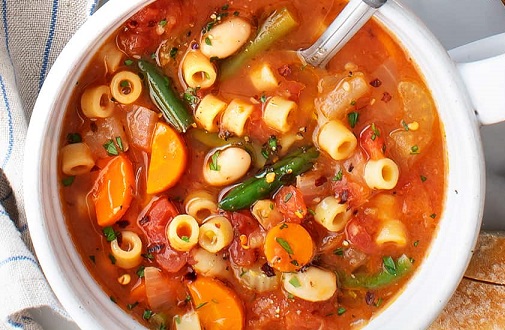Recipe | Picture | Ratings | Link |
Egg Drop Soup | |||
Spicy Chicken and Corn Soup |
Minestrone Soup
Minestrone soup is a hearty, flavorful, and versatile dish that hails from Italy. Known for its vibrant medley of vegetables, beans, and pasta, this soup is a celebration of fresh ingredients and rustic cooking.
Each region in Italy has its own variation of minestrone, reflecting the local produce and culinary traditions.
This recipe aims to capture the essence of a classic minestrone, offering a nourishing and satisfying meal that can be enjoyed any time of the year.
Whether served as a starter or a main course, minestrone soup is a wonderful way to incorporate a variety of vegetables and legumes into your diet.
Ingredients
For the Soup:
- 2 tablespoons olive oil
- 1 medium onion, finely chopped
- 2 cloves garlic, minced
- 2 carrots, peeled and diced
- 2 celery stalks, diced
- 1 zucchini, diced
- 1 yellow squash, diced
- 1 cup green beans, cut into 1-inch pieces
- 1 cup cabbage, shredded
- 1 can (14.5 ounces) diced tomatoes
- 6 cups vegetable broth (or chicken broth for a non-vegetarian option)
- 1 can (15 ounces) cannellini beans, drained and rinsed
- 1 can (15 ounces) red kidney beans, drained and rinsed
- 1 cup small pasta (such as ditalini or elbow macaroni)
- 1/2 cup fresh or frozen peas
- 1/4 cup tomato paste
- 1 teaspoon dried oregano
- 1 teaspoon dried basil
- 1 bay leaf
- Salt and freshly ground black pepper, to taste
- 1/4 cup fresh parsley, chopped
- 1/4 cup grated Parmesan cheese (optional, for serving)
How to Make Minestrone Soup
Step 1: Prepare the Vegetables
Start by preparing all the vegetables. Finely chop the onion, mince the garlic, and dice the carrots, celery, zucchini, and yellow squash. Cut the green beans into 1-inch pieces and shred the cabbage.
Step 2: Sauté the Aromatics
In a large pot or Dutch oven, heat the olive oil over medium heat. Add the chopped onion and sauté for about 5 minutes, or until it becomes translucent. Add the minced garlic and continue to sauté for another minute until fragrant.
Step 3: Add the Vegetables
Add the diced carrots, celery, zucchini, yellow squash, green beans, and cabbage to the pot. Stir to combine and cook for about 5-7 minutes, allowing the vegetables to soften slightly.
Step 4: Add the Tomatoes and Broth
Pour in the diced tomatoes (with their juices) and the tomato paste, stirring to combine with the vegetables. Add the vegetable broth and bring the mixture to a gentle boil.
Step 5: Add the Beans and Seasonings
Add the cannellini beans, red kidney beans, dried oregano, dried basil, and the bay leaf to the pot. Season with salt and freshly ground black pepper to taste. Stir well and let the soup simmer for about 20-25 minutes, allowing the flavors to meld together.
Recipe | Picture | Ratings | Link |
Shrimp Bisque | |||
Chicken Tortilla Soup |
Step 6: Cook the Pasta
While the soup is simmering, cook the pasta separately according to the package instructions until it is al dente. Drain and set aside. Cooking the pasta separately prevents it from becoming too soft and absorbing too much of the soup’s liquid.
Step 7: Add the Pasta and Peas
Once the soup has simmered and the vegetables are tender, add the cooked pasta and peas to the pot. Stir to combine and let the soup cook for an additional 5 minutes to heat through the pasta and peas.
Step 8: Adjust the Seasonings
Taste the soup and adjust the seasonings as needed. You may want to add more salt, pepper, or herbs to suit your preference. Remove the bay leaf before serving.
Step 9: Serve the Soup
Ladle the hot minestrone soup into bowls. Garnish with chopped fresh parsley and a sprinkle of grated Parmesan cheese if desired. Serve the soup with crusty bread or a side salad for a complete meal.
Chef’s Note
Vegetable Variety: Minestrone is highly versatile, so feel free to use whatever vegetables are in season or on hand. Leafy greens like spinach or kale, root vegetables like potatoes or sweet potatoes, and other beans like chickpeas can all be excellent additions.
Broth: For a richer flavor, use homemade vegetable or chicken broth. If using store-bought, opt for low-sodium varieties to control the saltiness of the soup.
Herb Flexibility: Fresh herbs like basil, oregano, and thyme can be used instead of dried herbs for a more vibrant flavor. Add them towards the end of cooking to preserve their freshness.
Gluten-Free Option: To make this soup gluten-free, use gluten-free pasta or omit the pasta altogether and add more beans or potatoes for heartiness.
Storage: Minestrone soup can be stored in an airtight container in the refrigerator for up to 4 days. It also freezes well for up to 3 months. When reheating, you may need to add a bit more broth or water to reach the desired consistency.
Nutrition Information (per serving)
- Calories: 250 kcal
- Carbohydrates: 45g
- Protein: 10g
- Fat: 5g
- Saturated Fat: 1g
- Cholesterol: 0mg
- Sodium: 800mg
- Potassium: 900mg
- Fiber: 10g
- Sugar: 8g
- Vitamin A: 5000 IU
- Vitamin C: 30mg
- Calcium: 150mg
- Iron: 4mg
Minestrone soup is a delightful example of how nutritious and delicious vegetables can be when combined in a single dish. This soup is perfect for meal prepping, feeding a crowd, or simply enjoying a warm, comforting bowl of goodness on a chilly day.
With its robust flavors and wholesome ingredients, minestrone soup is sure to become a favorite in your culinary repertoire.
Thanks for visiting Soups Recipe
Recipe | Picture | Ratings | Link |
Carrot Ginger Soup | |||
Chicken Noodle Soup | |||
Italian Sausage Soup | |||
Sopa de Mariscos |


Чёрные матовые подстолья — эффектный акцент в вашем интерьере
купить подстолье для стола купить подстолье для стола .